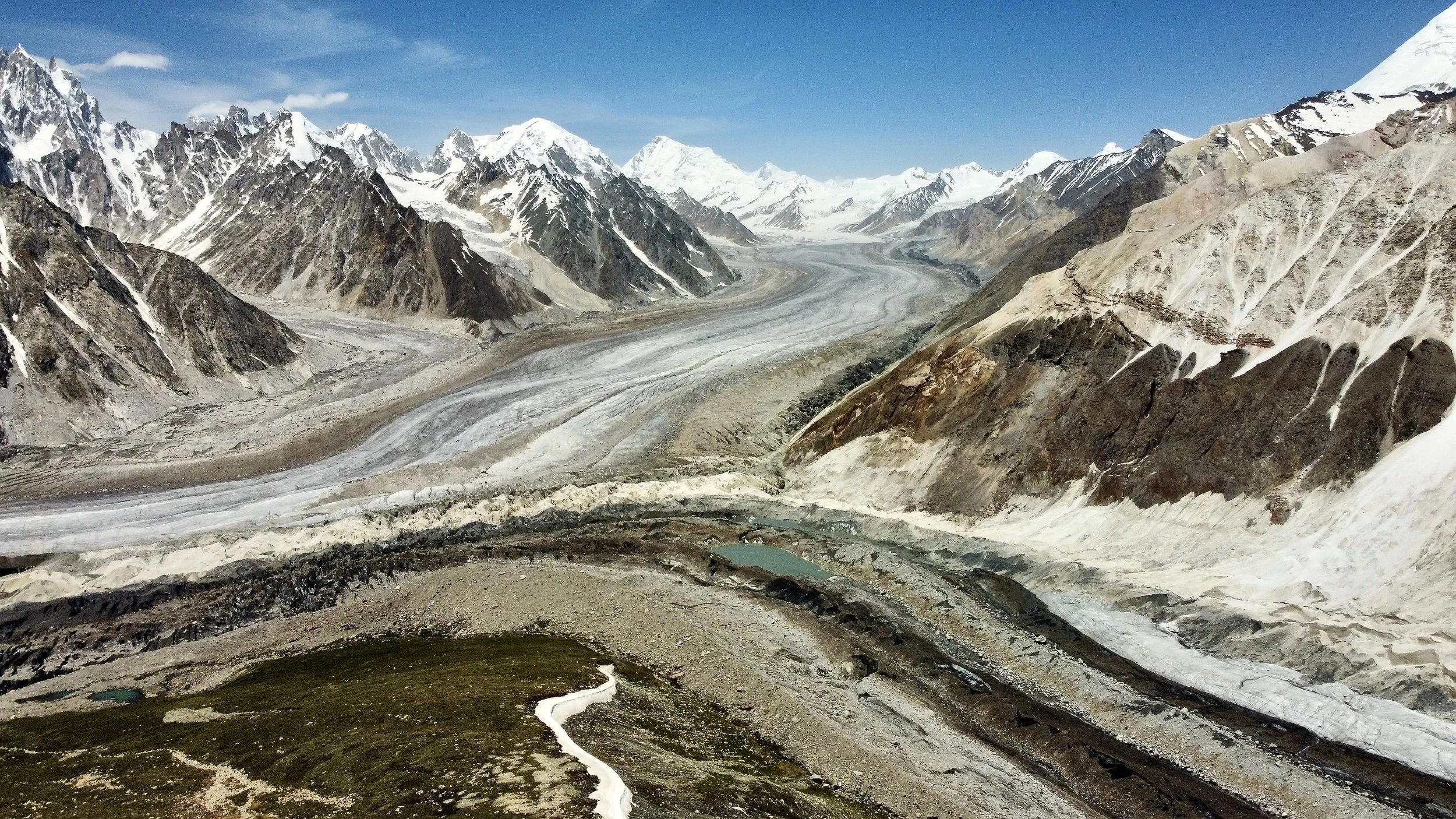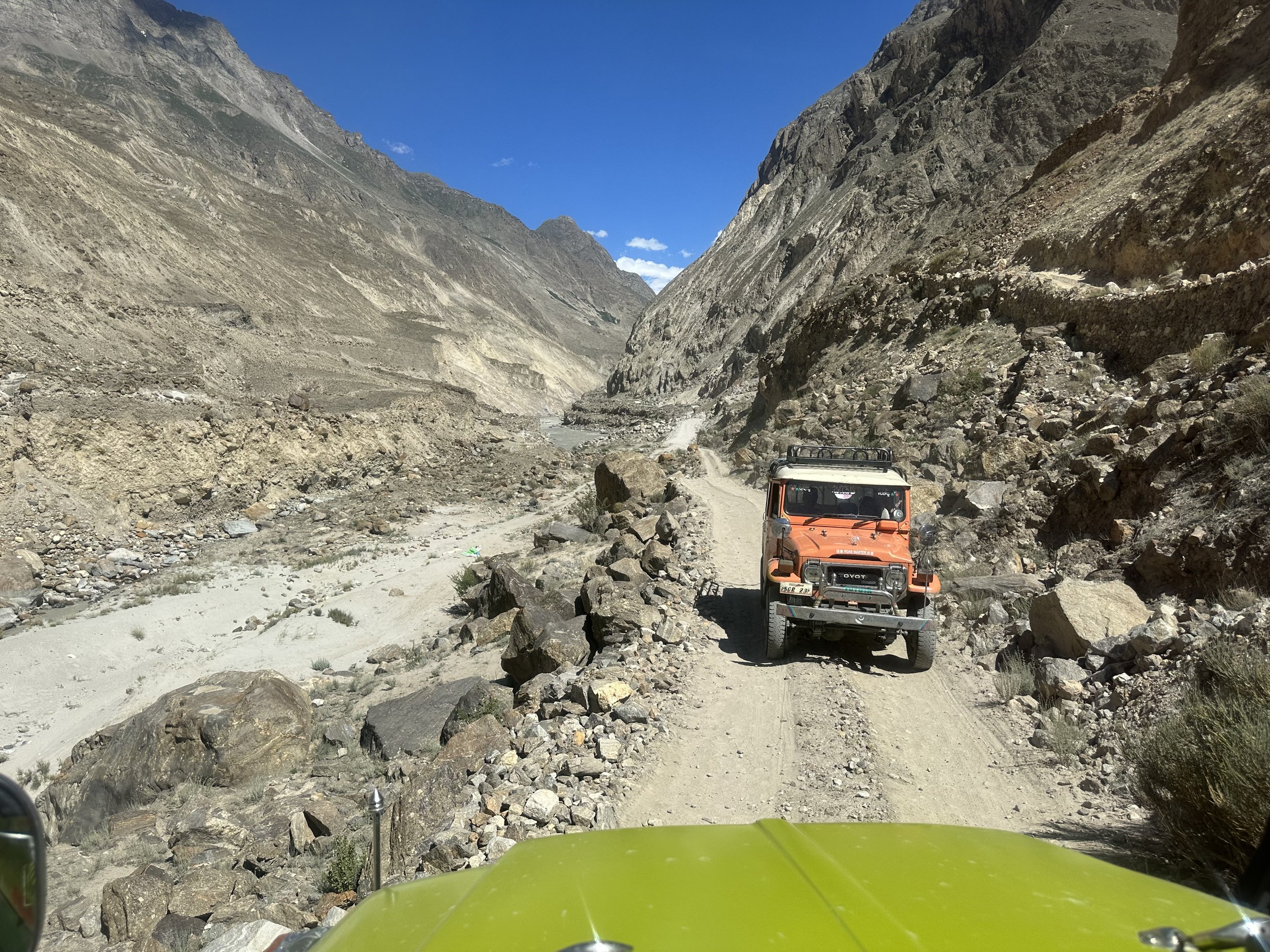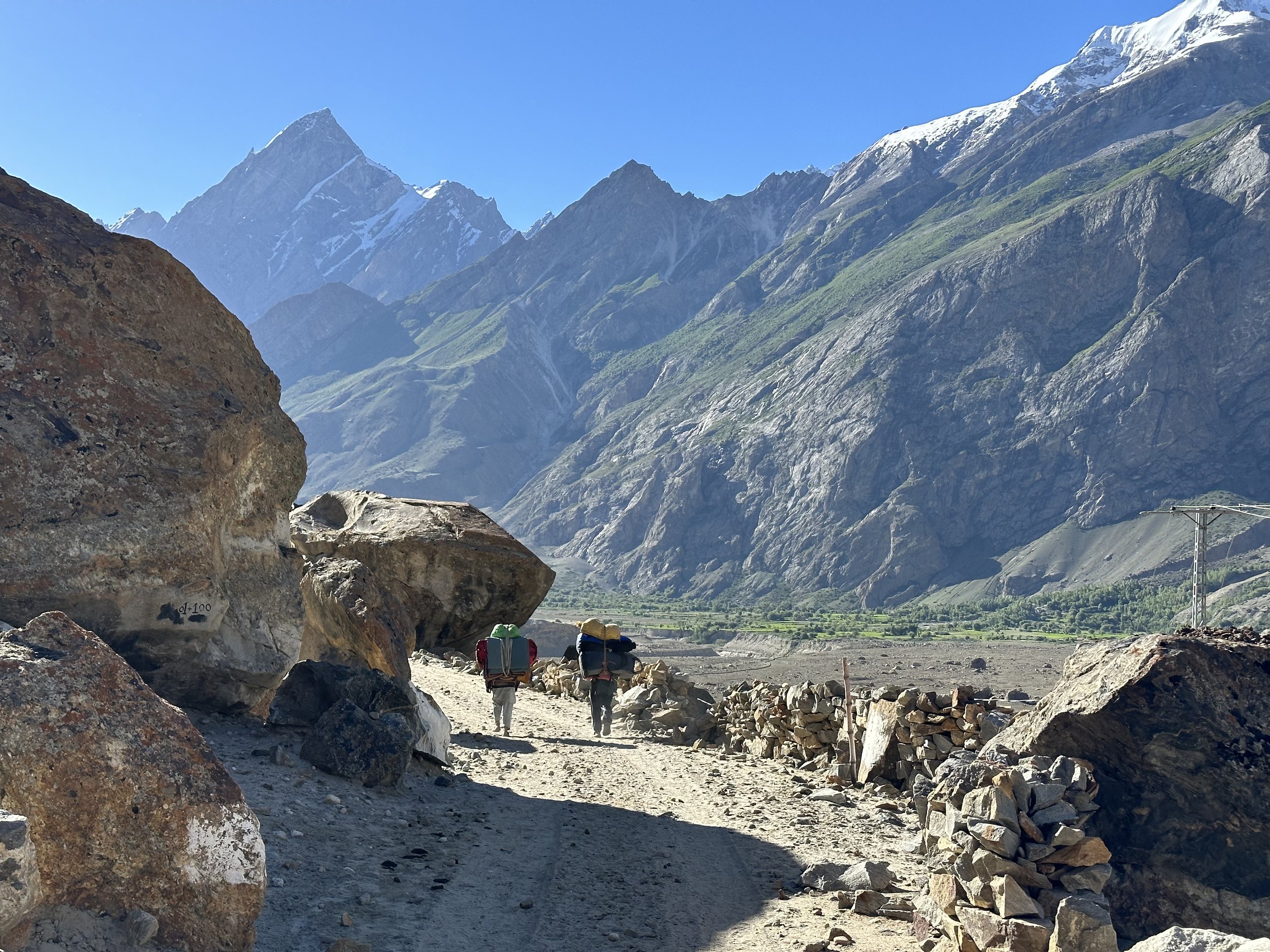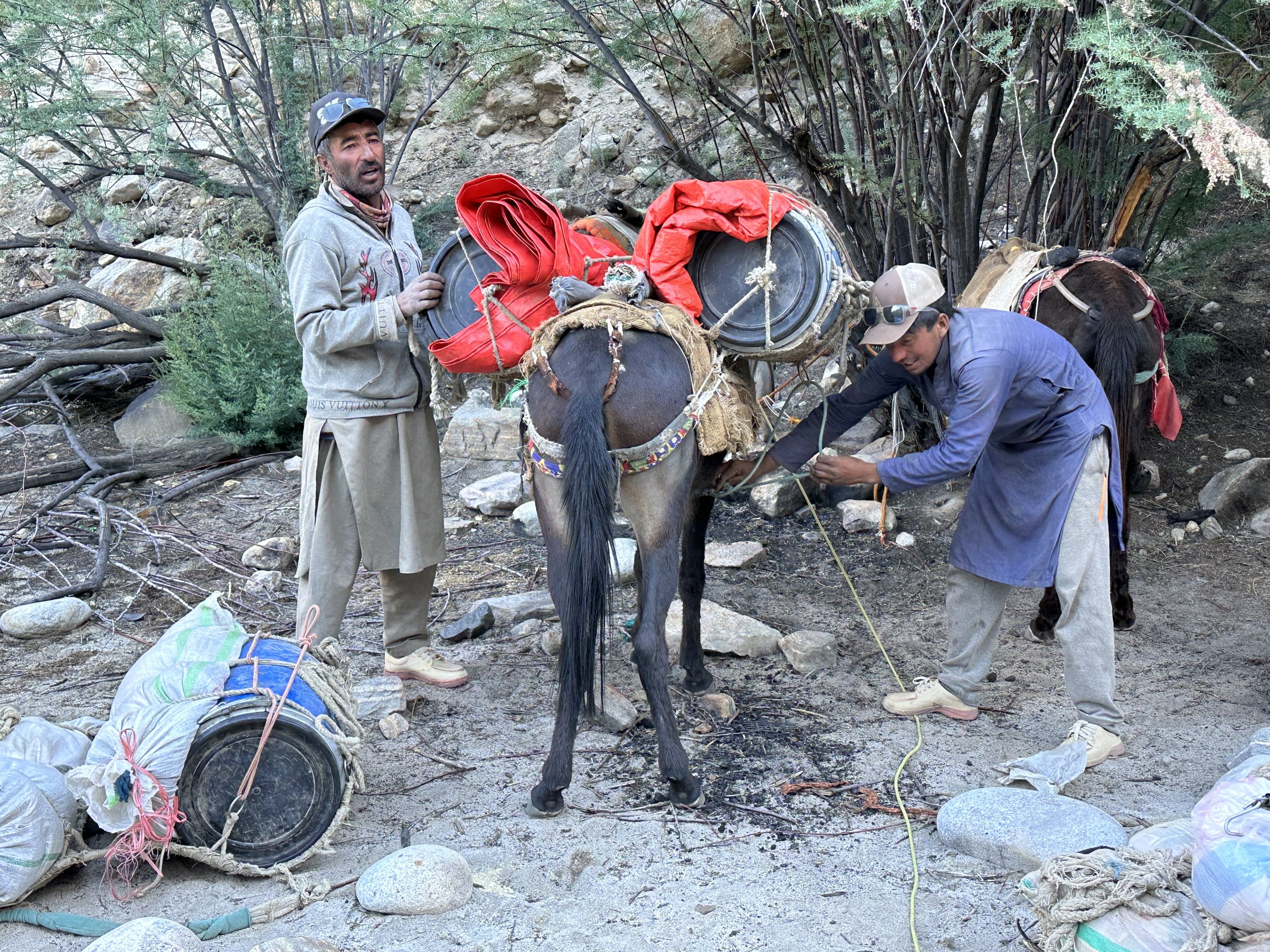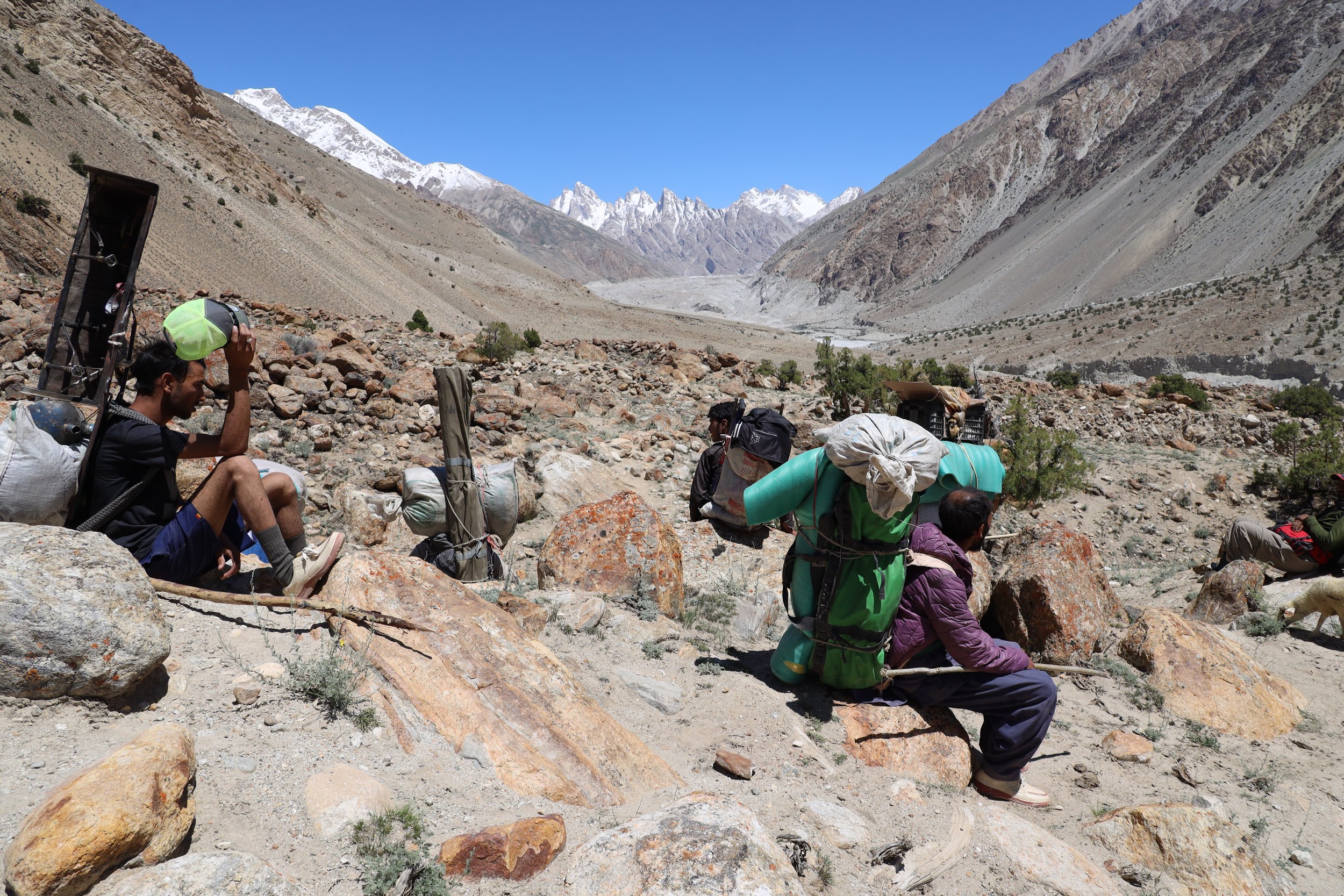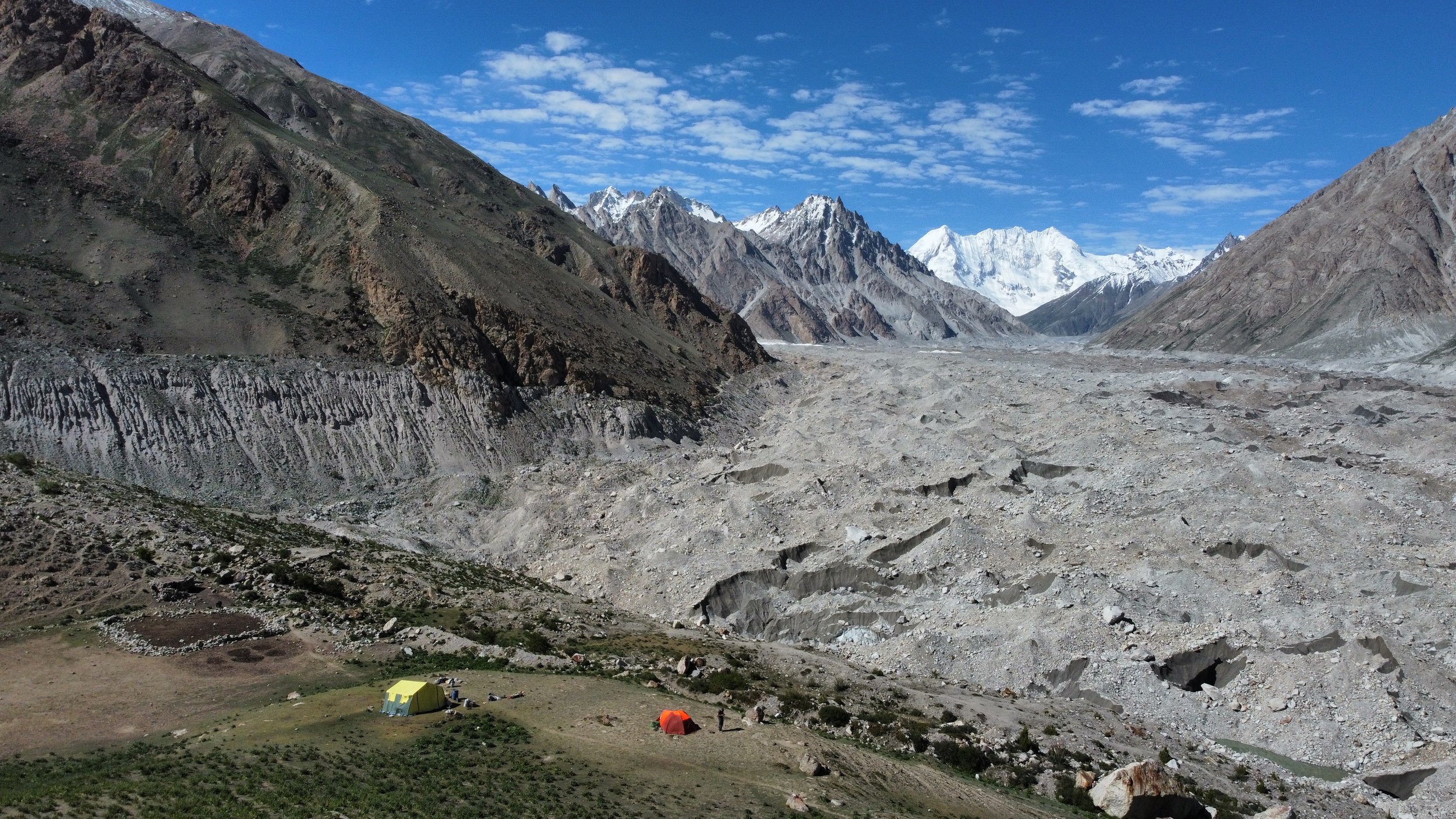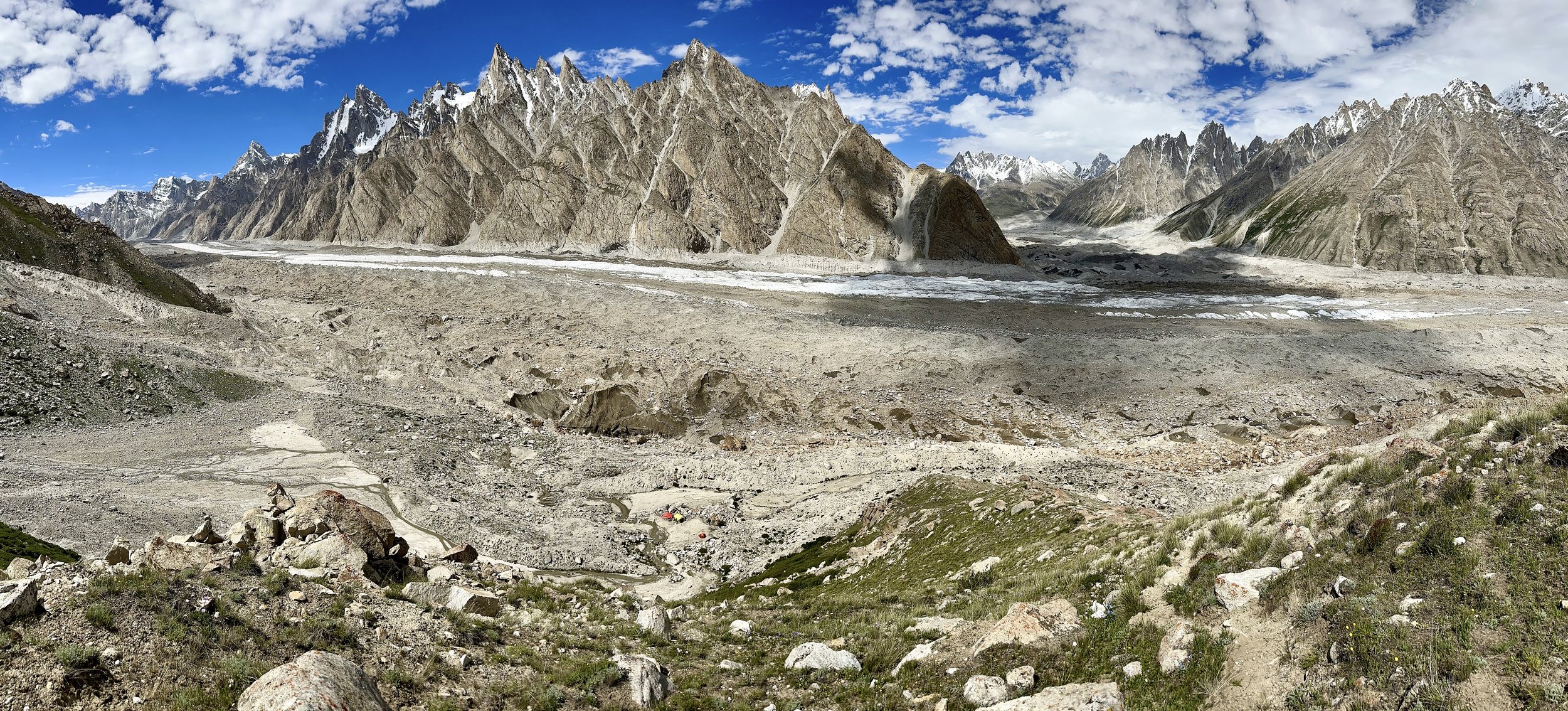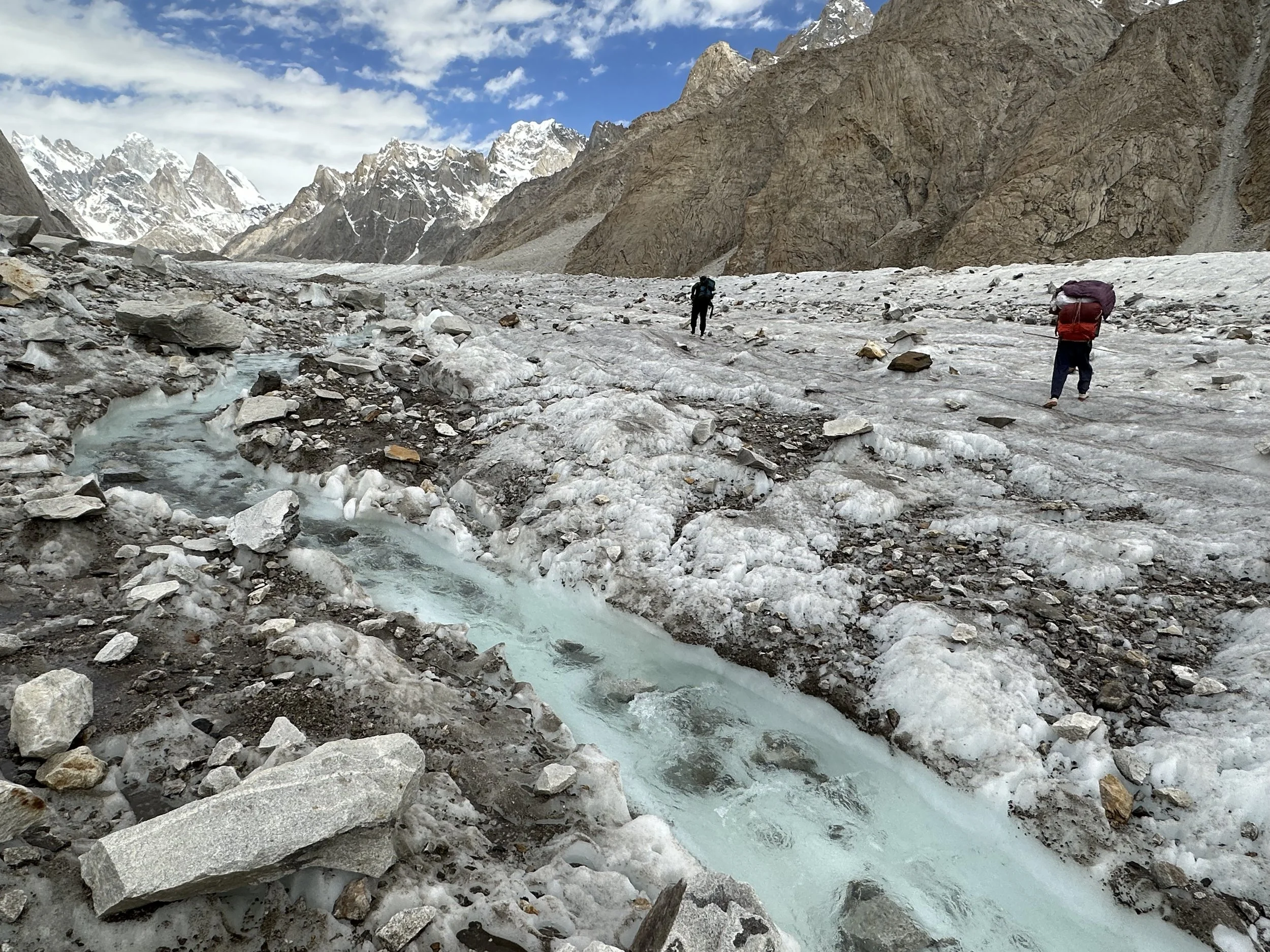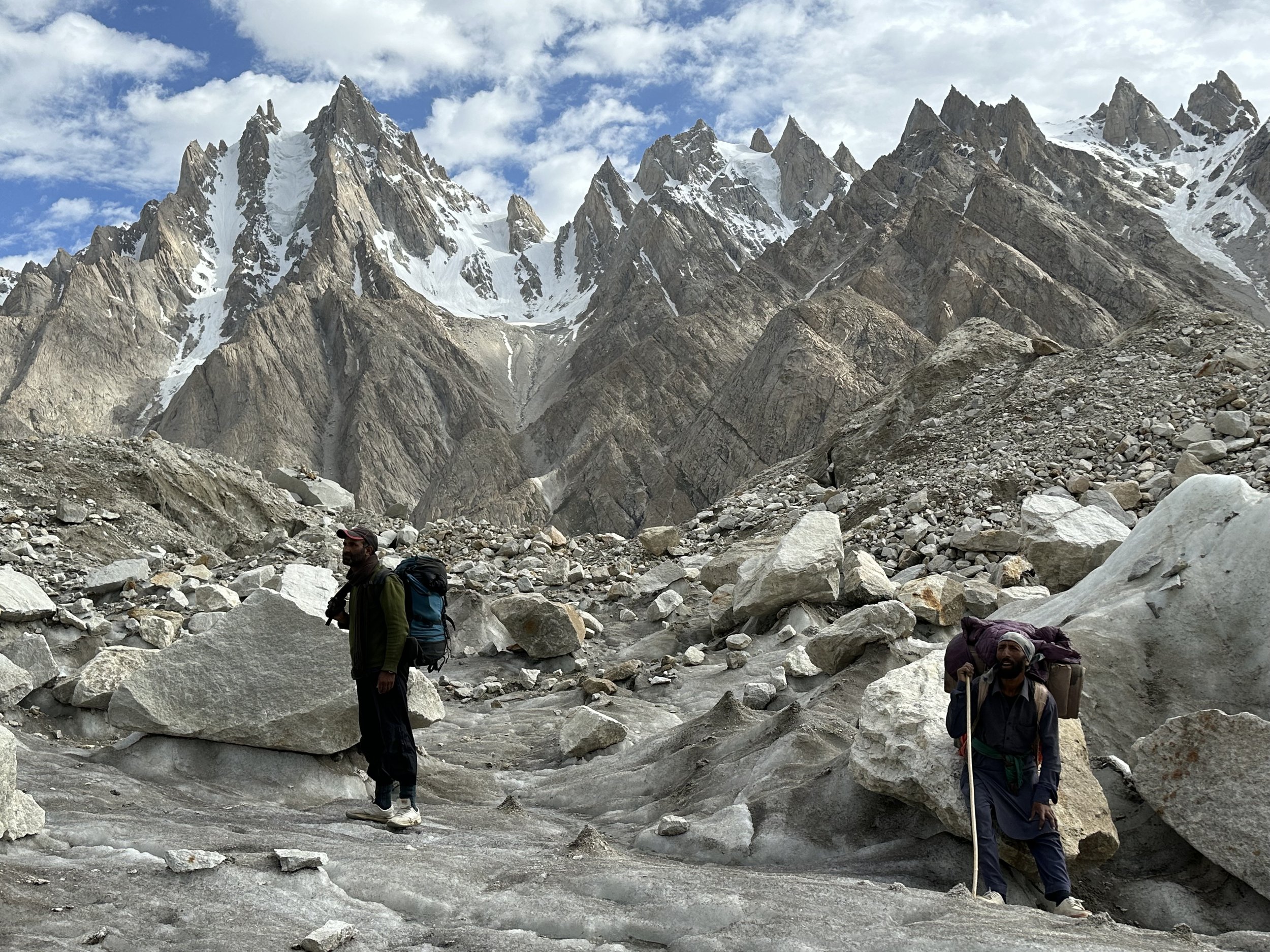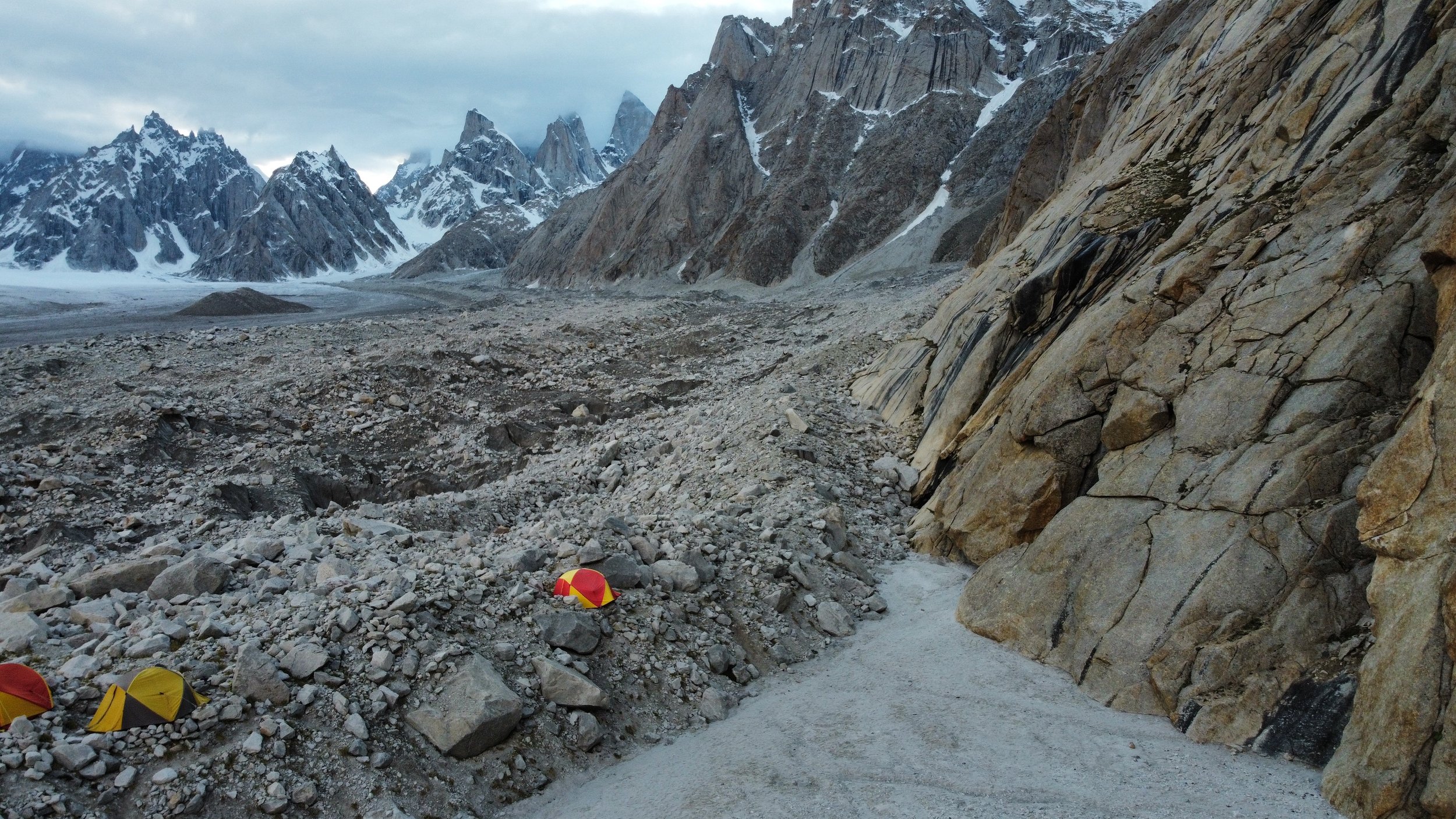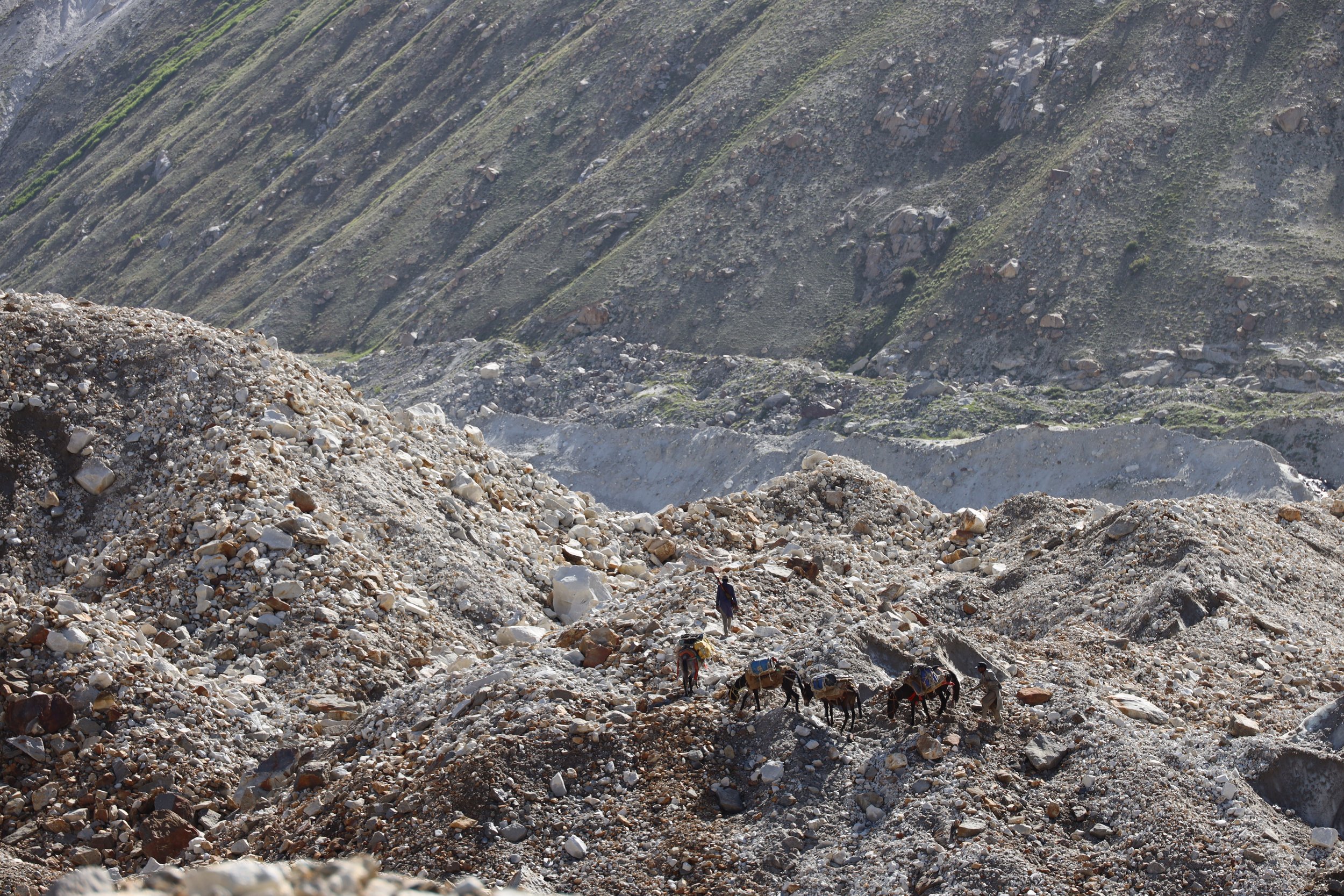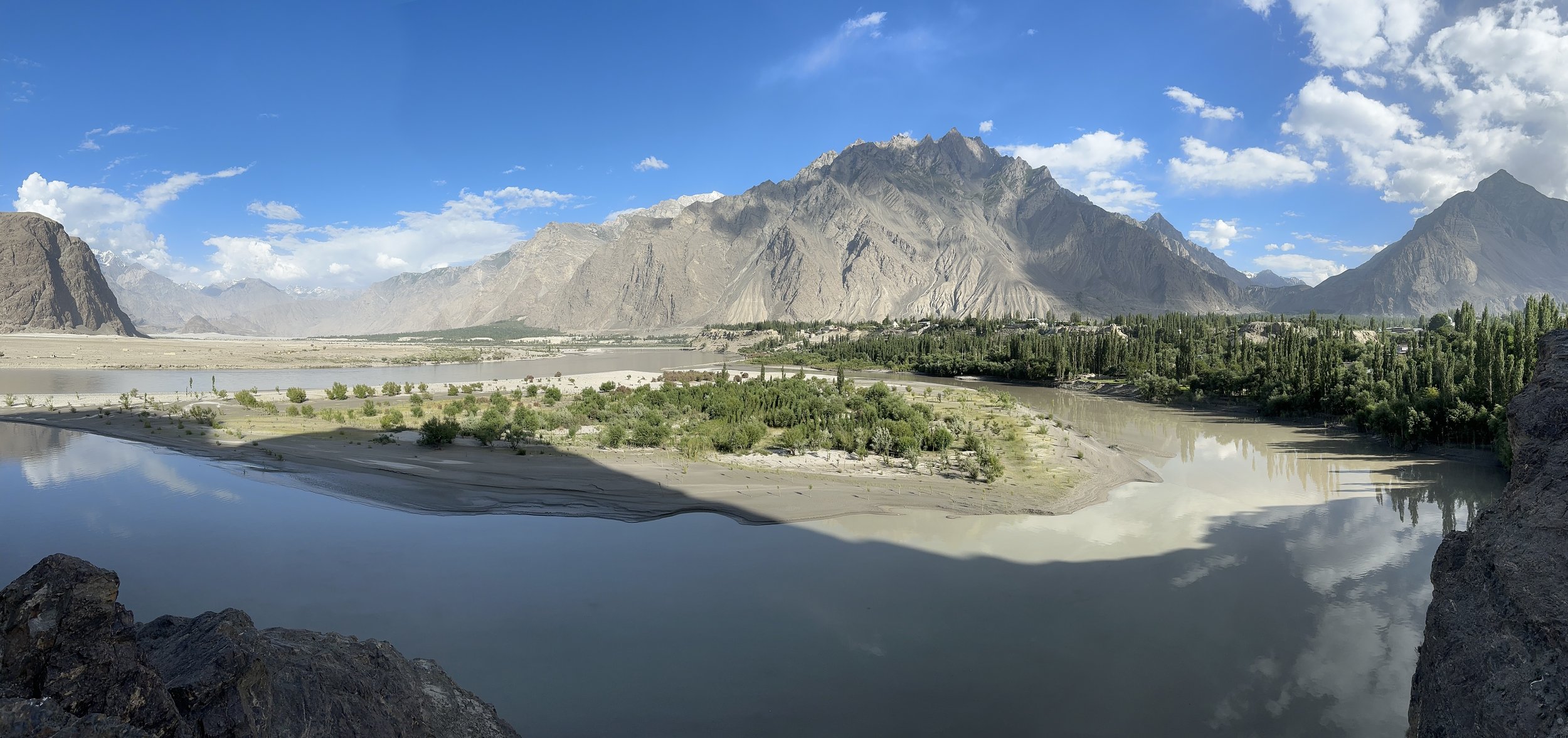I have been trying to organize a return trip to Pakistan for 10 years. Now, here I am, I am finally going! The process of organizing this trip was quite involved.
July 10, 2023 Skardu
I had a night connection from Doha to Islamabad. My flight departed Doha at 2 am and arrived at 7 am. Effectively, this was my second night without sleep due to flying. I was tired when I arrived in Pakistan.
Ghulam met me at the airport in Islamabad. We have not seen each other for 18 years! We had a nice cup of tea in the arrivals terminal and then went to Ghulam’s house where I stayed for the night. I caught a bug during the inbound trip and developed a sinus infection. This is not what you would want right before hitting the mountains and higher altitudes!
I rested during the morning and early afternoon and tried to get over the cold by taking some medications. Given my short stay in Islamabad I also wanted to visit Rawalpindi Raja Bazar. I enjoy the chaos and the hustle and bustle of the old Rawalpindi. I was surprised with the abundance of western junk food and sodas at the Bazar. There were a lot of people, cars and motorcycles and the resultant noise and commotion. The market was great, a typical Asian market with everything available for sale. I even run into local transvestites looking for cash donations. I took a few photos, but I was so tired and felt quite sick so I did not enjoy it as much as I should. Ghulam and I walked quite some distance and ended up at the far end of the bazar. To return to our starting point, we took a newly built train/bus that runs on an elevated platform. The entire visit to the bazar felt different from my first visit to Islamabad in 2001.
After the quick tour of the bazar, we went to the Kabul Restaurant in Islamabad for some good skewers and Afghani bread. The restaurant has delicious food but because of the jetlag and my cold I could not really enjoy it fully either. After the supper, I was very tired and went straight to bed. We had a long, two-day drive to Skardu ahead of us!
In the morning I felt much better. Amazing what a good night sleep can do! Ghulam hired a private car. We left Islamabad on a modern highway and drove in the direction of Peshawar. What a difference from the old Great Trunk Road from 2005! I must admit that the old road was more charming. After Abbottabad we joined the Naran/Babusar Pass road. It was busy as many domestic tourists were going to the Naran Valley (Pakistan’s chic mountain resort). On the way, we took a detour to buy big bags of onions and tomatoes. Apparently Skardu has some transportation problems affecting the availability of onions. Ghulam and the driver bought enough onions and tomatoes to last them for a year! The detour provided me with an opportunity to take interesting photos of the local men.
The Naran road was all new to me. In 2005 this valley was considered too dangerous for tourists, and everyone took the Karakorum Highway instead. Now, Naran has been built up and serves as the closest mountain retreat from the heat of the low-lying Punjab mega cities.
The Pakistani middle class must be quite numerous judging from the number of cars and people heading to Naran. Our driver was like a Formula 1 driver: speeding whenever he could, overusing his horn and not following the rules of the road. At one spot, mid-way up the Naran Valley, we were slowed down at a Chinese Dam construction site. The road around the construction site was in a state of chaos. The traffic was being diverted to a temporary road to bypass the construction resulting in a big delay.
As we progressed along the Naran Valley, the scenery became grander and increasingly mountainous. We could see snow-capped mountains on the horizon far away. These peaks form part of the Himalayan Range. We were now surrounded by 4000m hills covered in lush pine forests and a lot of development! As we approached the town of Naran, there were more and more hotels, resorts and restaurants. There were a lot of tourists, and the traffic was bad. It was hardly a spot to relax.
We arrived in Naran around 5pm and had a dinner for which I had no appetite, in one of the large hotels. We tried to find a place to overnight, but everything was booked up. We continued to Babusar Pass at 4000m. Despite speeding, we arrived at the pass in the dark which was unfortunate as the scenery from the Pass would be interesting to see. There were still large patches of snow on the pass, and it was much colder which gives an idea of the amount of snowfall in this area during the winter and spring.
From the pass we descended endless switchbacks to the Kagan Valley and stayed in the old PTDC Guesthouse where we were the only guests. The rooms were nice, cold but comfortable. In the morning we continued to Chilas through a scenic Kagan Valley with old villages clinging to the steep valley. This is a Pashtun area, and the people look different. Their villages look medieval. I would have liked to stop for some photos, but our driver was racing at full speed. By the time I saw something interesting, we were already 5 km ahead.
On exiting the Kagan Valley, we stopped at a police checkpoint where a curious policeman was quite inquisitive about my trip.
In Chilas we rejoined the old Karakoram Highway and it started to feel somewhat familiar. I really like this drive and I think it is much more interesting than flying. It gives you time to transition from the city to the mountains. It passes though some interesting villages and towns and the scenery is spectacular. I felt happy to be back on the KKH and in Northern Pakistan. The road has been vastly improved and our driver took good advantage of it by speeding up to 120km/h (this would be impossible in 2005).
The Jaglot – Skardu section is 160km long and follows the Indus River gorge. The new road is better for driving but worst for scenery and lacks the dramatic tight corners and overhanging rocky outcrops. There are also very few spots to pull over for photos. Although the scenery is spectacular, it is hard to capture it on film. The road is lined with vertical cliffs with snow covered mountains towering above. We passed Sasso, the exit point from the Haramosh Pass where we would end up in a few weeks. The driver was going way too fast to enjoy the scenery and take any good photos. By 2 pm we were in Skardu. Total driving time was 11 hrs yesterday and 6 hrs today.
My first impression of Skardu after such a long time was that it has grown a lot! I did not recognize it. It felt very dusty, crowded and chaotic with many concrete buildings in various stages of completion. It was not very inviting to walk around, and I have not ventured out on my own at all. It was tiring just to look at it. We stopped for lunch at a hotel run by Ghulam’s friend. Ghulam called ahead and asked for a meal with as little grease as possible to which they obliged with good results. After lunch it was a quick drive to Ghulam’s beautiful house. The house fronts as a guest house and has a palatial feel to it. The compound is surrounded by a lush garden and high walls separating it from the chaos of the outside world.
July 11, 2023 Skardu
In the morning I met Essan, my guide for both treks of this trip. Essan is from Shigar Valley and has experience in all aspects of mountain work. He worked as a cook, high altitude porter and a trekking guide. He worked with Artur Hajzer and Marcin Kaczkan during the tragic expedition to G2 during which Hajzer lost his life. He told me some interesting stories about that experience. He assured me that he visited all the areas that we were going to visit and was familiar with the routes and the terrain. Essan was entrusted with organizing all the permits and logistics. In the early afternoon we had to go to the Ministry of Tourism office to finalize the permits and sign some papers. According to the permits, I was both the Tour Leader and the only Tour member. As a tour leader I had to sign the promise that all tour members would obey all the rules and in case of non-compliance, I would be held responsible as the tour leader. In order to complete the permit process, I had to get photos taken and return them to the office. In addition to the requirements of the Tourism Office, we had to send a multitude of documents to the Military Command for more permits as we were travelling in the Pak-China border zone. I received all the permits by 10pm and we were supposed to leave the next day at 7 am.
While all the offices were working their permit magic, Ghulam’s son and I went to the Skardu Fort and a place called Organic Village which is situated behind the Fort on the banks of the Indus River. It is a nice walk with a different views of the Indus River and the surrounding mountains. I took some great photos of the Indus River Valley in the late afternoon sun. We had some fresh mangoes on the bank of the Indus and enjoyed the beautiful afternoon. On the way back we climbed to the Fort for a good view of Skardu in the sunset accompanied by the cacophony of the evening prayer calls coming simultaneously from dozen mosques below. The multitude of calls made them indistinguishable and resulted in one big noise.
On the way to the fort, I met a teacher from the Gilgit Military School who was a very kind man. He paid for my ticket to the fort, and we took some photos and videos together. On the way up I also met many Pakistanis that were very interested in talking to me and wanted to take photos. I guess there are not too many tourists here. After the trip to the Fort, I had a good, although late dinner with Ghulam and got ready for the 7 am start the next day. I repacked and left some things behind.
July 12, 2023 Skardu – Askole
Our trip to Askole started at 8.40 am. We picked up Essan in Skardu and purchased additional supplies along the way. Skardu was hot, busy and dusty and it felt good to leave it behind. Skardu has expanded a lot, it is a medium size city now. The infrastructure can’t cope with the pace of the development and water and electricity shortages are common.
The drive to Askole takes now only 7 hours as the road has been improved. It is now paved all the way to Shigar and after that it is still much better than it was before. The road was paved to enable numerous visitors access to the valley. The Shigar Fort has been converted into a luxury hotel and the amenities have improved along with the development in the area.
Shigar Valley is very beautiful. It is full of green fields with snow-capped mountains above the many villages on the Shigar River. We stopped in Shigar to check out the 150-year-old mosque. Its appearance is quite reminiscent of the Central Asian mosques that I saw in Xinjiang. In Dasso we picked up additional porters. Most of them came from Tissar village on the opposite side of the Shigar River. I crossed this river on the way to Arando on the second leg of the journey two weeks later.
The road we were on is very dramatic. It follows the Braldu River gorge. The Braldu River is the main drainage of the massive glacier system of the Central Karakorum Range. There were 10 of us in the jeep – Iqbal, porters, Essan and me. The weather was perfect and the scenery beautiful all the way to Askole. The grandeur of the Karakorum was on full display. The drive seemed much faster than in 2005 and we did not have to stop to cross any rivers or streams. We arrived in Askole at 4 pm at a tidy new campsite located at the edge of the village. The campsite is run by the village association, and it has toilets, water source, garbage cans and a shelter for porters. We pitched our tents and sorted the gear. Ghulam ‘s new tent was the size of a Tajma Hall! It is very comfortable for one person. Askole also changed a lot. It has concrete buildings, a few shops, a hotel and a couple of real streets. It also has a museum displaying some local culture. I also saw many women this time, which was unheard of in 2001 or 2005. People look much better, wearing clean clothing and looking healthier.
We spent the afternoon in Askole, walked around, took photos with local men and visited the museum. Some large trekking groups arrived after us. One of them was Polish. They were all going to K2 which apparently became quite a popular trek by the Karakorum standards. Later I met them again and learned that they had not been able to cross the Ghondogoro La pass due to bad conditions.
In the evening, the Askole chief came to visit us. He knows Iqbal (Iqbal worked in Askole for a while for an NGO). The Chief heard that we were going to the Choktoi Glacier and the Latok 1 basecamp. He showed us some books (in a state of total disintegration) of the Latok Peaks published and given to him by the Huber brothers. The Panamagh and Choktoi drainage is popular with the locals for ibex hunting. People venture there even in winter when the ibex come down to the valley. We had a delicious dinner and a good chat into the late hours of the evening.
July 13, 2023 Askole – Camp 1, 20km 400m
Today is the first day of trekking. I got up at 5 am to start early and to avoid the 40C heat. The process of organizing 15 porters and 5 horses took some time. It is difficult for me to believe that all this gear and supplies is just to facilitate one person’s trek.
We left at 7 am and walked initially on the Askole-Jula jeep track. We had to detour into the National Park office to register my name. This is a new development as I am not sure if the National Park even existed in 2001 or 2005.
The army attempted to expand the road but were defeated by the river flowing from the Biaffo Glacier. The river took out the jeep bridge making the road impassable. We had a lunch break at the Karaphong camp by the snout of the Biaffo Glacier. The scenery looked familiar. This was the third time on this section of the trek for me. As the day went on the heat started to increase and by early afternoon it was 40C, just as I remembered it! It is difficult to walk in the heat with strong warm wind speeding up the dehydration process. We had a few breaks in the scarce shade and finally reached the first camp at 2 pm. We camped in the narrow canyon of the Panamagh River, loud and turbulent from volume of the melt from the massive glaciers up the valley. The water in the river was a brown mess not suitable for drinking or even washing. The potable water is sourced from a small stream nearby. Although there are numerous glaciers, water suitable for drinking is always an issue here. The Karakorum is a high-altitude desert.
Essan, my guide is a nice, no-nonsense kind of guy. He is a carpenter by trade, lives in Tissar, has 5 kids and a wife. His English is OK but not sufficient for any meaningful conversation. He has 2 kitchen helpers (I established later that one of them was his son and the other, Aslam was married to his wife’s sister). They also help him with English when he is lost for words.
The horse men from Askole were also quite nice. One had a fake LV hoodie with the word “Danger” written on it. I nicknamed him the “Danger Man”. He also carried and old gun for hunting opportunities during our stops. This is a big ibex grazing area. Since there are very few people, the animals are easier to spot and hunt. We had 5 small horses that carried quite a lot of our supplies. These horses crossed some incredible terrain. I was very surprised to see that horses can navigate glacial terrain so efficiently.
I was quite tired after today’s walk due to the heat. Tomorrow is supposed to be less walking in the heat and perhaps we can be better organized to leave early.
July 14, 2023 Camp 1 – Camp 2, 7 hrs 18.5 km 1000m elevation gain
Today was supposed to be shorter and easier but it turned out to be longer and harder. This was to be the case for most days here. I made a mistake of developing expectations for each day by asking Essan. However, Essan’s description of what each day would bring usually would not be accurate. I should have remembered my 2001 experience when the answer to how far the campsite was, was always 20 minutes, regardless of the actual distance ahead.
We started by following a faint trail along the Panamagh River. I remember looking up this river valley from the first campsite on the route to K2 in 2001 and wandering what was up this valley. Now I am going there to explore it! How exciting!
As we gained elevation, the valley opened, and the scenery became more dramatic. We could see into the far reaches of the valley where jagged peaks came into view above massive Panamagh Glacier. The trail crossed many side drainages formed by water draining from the peaks and glaciers above. The drainages made deep indentations that required downclimbing and then climbing up. There were quite a few of them that needed to be crossed. Since we had no rain, the crossings were easy, and we did not encounter any difficulties. At one point we had to negotiate a large, eroded cliff with loose stones and no foot holds. The climbing on the loose ground in 40C heat was hard but it did not feel as hard as the day before. I used a small towel soaked with cold stream water to wrap it around my neck which helped to cool down.
We passed the Panamagh Glacier camp site located at the frontal moraine but decided to press on further on the recommendation of the horsemen, up a hill for one more hour. The Cow Camp as the horsemen called it, was in a spectacular location perched above the Panamagh Glacier with a commanding view of the surrounding mountains. The snowy Skamri Peaks were visible at the head of the valley 40km away to the northwest. This is such a spectacular area and there are no other groups or trekkers here as everyone is headed to the K2 BC. Karakorum sees very few trekkers compared to Nepal. Maybe a few hundred people trek here each summer compared to tens of thousands in Nepal. This is a grand place to chill, listen to music and admire spectacular scenery. I am so lucky and feel so happy to be back in the Karakorum and to be able to see and experience this spectacular beauty.
We had a good dinner of chicken in a tomato sauce. The food so far is not greasy and quite good. We have fresh vegetables and fruit including fresh mangoes. The dinner is at 7, bed by 8 and wakeup at 5am. The breakfast is at 6 and by the time I arrive for breakfast I am all packed up and ready to go. The porters seem a good group of guys, but it feels different to be alone with 12 Baltis and to be completely dependent on them.
July 15 Moretti Camp 4100m 8.5 km
Today was a short day. I got up at night to pee and could not see any stars. I thought that the good weather was over but miraculously by morning it was clear and sunny. I am a little paranoid about the weather here. I remember the bad weather days on previous treks.
The way to our next camp was blocked by a side glacier and a river coming out if its snout. The river did not seem very large from the distance. Once we approached it though, the river was a brown torrent of cold water too dangerous to cross, even first thing in the morning. We decided to take a detour and walk over the Panamagh Glacier to the other side of the valley where we would rejoin the trail. The detour was my re-introduction to the world of jumbled ice and loose rocks – the world I would be experiencing for the next three weeks. Unlike the Baltoro Glacier, there are no trails on glaciers here.
The river disappeared under the Panamagh Glacier, so we had to climb over the glacier to bypass it. The glacier is a jumbled mess of rocks some as large as houses precariously balancing on top of one another. Some boulders sit on top of ice ridges and will slide with a small push or disturbance. It does not look difficult, but it is tedious and slow. Each step must be carefully placed as a slip could result in a twisted ankle or a broken leg. Each rock is precariously balanced on another rock or ice ridge. The off-trail glacier travel means negotiating boulders in a maze of ice passages.
This bypass added at least one hour to our day but since the distance was short, it did not matter. Once we reached the other side, we ascended a grassy hill and regained the trail. The trail went along and above the glacier with spectacular views. Absolutely stunning. As we approached the Moretti Camp, the teeth like peaks on the north side of the Choktoi Glacier came into view. The panorama was stunning: sharp, steep towers line the surrounding glaciers. These do not look like normal mountains but like dinosaur teeth.
The Moretti Camp is in a spectacular setting at the confluence of the Choktoi and Panamagh Glaciers with freshwater stream running through it. The stream originates from the small hanging glacier above the camp that we could see. The camp was hidden behind a side moraine of the Choktoi Glacier. We were now 4 hours away from the Latok BC. We arrived at the campsite at 10am so I had the entire day to enjoy the magnificence surrounding us.
I climbed the hill behind the camp to get a commanding view of the area and our camp. The terrain here is very big and dramatic. What looks near is actually 10-15 or 40 km away involving walking on challenging terrain and, so far, in the heat. It is hard to get a sense of scale as everything is big. It is also hard to believe that one can get a heat stroke walking on a massive glacier. It is all very spectacular! Tomorrow we are going to the Latok BC and I hope that the weather does not change. At least for one more day. Ominously, in the evening though, some high clouds appeared and made me worried that the weather was about to change.
July 16, Latok BC, 12 km each way 400m gain
For the overnight trip to the Latok BC I took my own tent. We also took enough food for one night. When we left the weather was sunny and clear. As we started our ascent up the Choktoi Glacier it started to cloud over but we still had good visibility of the spectacular mountains at the head of the Choktoi Glacier, the teeth like towers on the north side and the Latok 4 on the south side. The summit of Latok 3 was hidden in the clouds. The walk was fairly flat. We started on the side moraine, then descended onto the jumbled Choktoi Glacier which made walking more challenging. Slowly, we made our way to the middle of the glacier onto the white ice highway. As we continued, the scenery got more and more spectacular. The mountains lining up the upper Choktoi Glacier are just amazing, triangular towers so sharp, one next to the other. We passed by Latok 4 and 3 with the walls like bastions of a medieval castle just 100 times larger. Each of the Latoks had large icefall and glacier descending from it. All peaks of the Latok group are surrounded by dragon teeth mountains and towers, such a foreboding sight.
As we approached the BC, we had to leave the ice highway and climb up a small rocky lateral moraine. The BC was hidden behind this lateral moraine. When we arrived in the BC the clouds already obscured the view of Latok 1 and the Ogre. I was disappointed but there was nothing I could do. There was a climbing party in the basecamp, so we were not alone. As we arrived, two climbers were leaving for their attempt on Ogre 1. We had a brief chat. The leader, François Cazanelli (a famous and very accomplished Italian climber), invited me in and offered their camp to us. This was extreme hospitality! He even offered us their tents. I had my own tent so there was no need to use someone else’s. I pitched my tent and had a delicious lunch. Even with the overcast conditions, it was such a spectacular place to be in. The location of the BC is very dramatic: perched above the Choktoi Glacier with 180-degree view of all the Latok Peaks and the Ogre1 and 2. A magnificent panorama.
In the evening, the clouds parted, and the scenery became the photographer’s dream. The dramatic clouds with sun rays bursting through made the scenery very photogenic. In a way it was much more spectacular than a clear blue sky – very mysterious and dramatic. I was thinking about the documentary I saw on YouTube called “Impossible is not Forever”. The documentary is about the accident on the Latok 1 that killed Sergei Glazunov. Another recent accident on Ogre 2 killed two famous and accomplished Americans: Kyle Dempster and Scott Adamson. Their bodies were sill somewhere on the mountain as none of them was ever found.
After my photo fest, I chatted with the Pakistani liaison officer of the European expedition. He was a nice young guy who volunteered to be here. He is an aviation electronics engineer who wanted to see the high Karakorum mountains and working with the mountaineering expedition provided him with this opportunity. He was taking drone shots and showed me some footage taken in clear weather. Of course, it was all very spectacular.
It rained heavy all night and despite the forecast for clear sky it just got progressively worst in the night. It was too bad, but I was not too stressed as there was nothing that I do.
July 17, 2023 Walk back to Moretti Camp 12 km 400m down
We got up early to overcast sky and drizzle. Around 7 am the four Europeans arrived from their attempt on Ogre 1 all wet, cold and miserable. They complained about the bad conditions, it was too warm, there was a lot of unconsolidated snow. The distance from the BC where we were, to the Ogre’s icefall is 10 km. It takes 5 hours on foot and skis to cover this distance. The climb up the Ogre involves gaining a 6000m col between Ogre 1 and 2. The climbing to the Col is not too bad, but the conditions make it dangerous. Francois is a mountain guide from Cervinia area of Italy (Italian side of Matterhorn). He climbed K2 and Nanga Parbat without O2 the year prior. He and his friends were extremely friendly and hospitable. I was the first and only foreigner that they saw during their stay in the BC.
In order to see the entire face of Latok 1 it is necessary to go for a few more hours up the Choktoi Glacier as the peak is really hidden around the bend. The entire Latok/Ogre group is very well hidden and requires a considerable effort to reach. The camp closest to the mountain has too much snow and is very difficult to reach without skis (even in mid-July). The Ogre climb involves a long approach on skis (5 hours), then night climb through the icefall (at night everything is frozen, so it is safer), then a climb to the col between Ogre 1 and 2 and then the real climbing starts. The entire adventure requires minimum 6 days of good weather but the weather windows here are short and unpredictable. The Europeans never had such a long weather window. The route is exposed to rockfall, avalanches and crevasses on the approach. The guys have been sitting here for 3 weeks already and it did not look promising. Climbing here requires patience and good spirits. It is easy to get discouraged with bad weather and boredom. I think that August is the proper month to come here. July is too early and there is too much snow higher up.
Around lunch time the clouds parted a little, but Latok 1 was still covered by a thick layer of clouds. The weather did not look promising to justify staying here for another night, so we started our return journey right after lunch. We had a nice walk down. I flew the drone for some great shots of the Choktoi Glacier. It then became quite hot. What a change in the weather from 5C to 30C in a short time. In retrospect, we should have stayed another night in the BC. An important lesson learned: do not rush and be patient!
July 18, Moretti Camp to Nobande Sobande 18.5km 7.5 hrs 400m up and 400m down
Today we started early. We packed up the camp and followed the path across the glacier that the horsemen scouted the day before. They wanted to ensure safe passage for the loaded horses. I was not expecting to spend the entire day boulder hopping on this massive glacier, but this is what happened.
We crossed the 4 km wide Panamagh Glacier. According to Essan, there was supposed to be a path to follow on the other side. The path only lasted for 20 min and after that we had to descend onto a side glacier connected to Nobande Sobande Glacier (NS). We then spent next 4 hours boulder hopping, going up and down large ice fins slowly making our way towards the next camp. It was quite exhausting in the heat of the day, and our progress was slow. We had to watch each step carefully as the boulders we were walking on were just piled up on top of one another. We ended up climbing some challenging sections with large stones ready to dislodge every minute. The fact that 5 horses crossed this glacier is quite astonishing! After 7 hours or so I started to get quite tired and had to stop now and again. It was good that we had water as I drank more than 4 liters.
After the final steep climb up the side moraine, we finally arrived in a beautiful campsite situated between green lakes. We were now quite close to the massive wall of the Skamri Peak. The Skamri Glacier originates from this mountain on the Chinese (north) side. I saw the glacier and the mountain in the distance from the vicinity of the K2 Chinese BC in China in 2016. Our camp is as spectacular as all the other camps so far. It is too bad that I am so tired and can’t just hop around the surrounding hills. Perhaps I am still not sufficiently acclimatized or maybe I have some lingering effects from the cold.
Our camp is located at the bend of the NS Glacier and the surrounding hills (5000m + mountains really) offer magnificent vistas. Looking towards the Moretti Camp from the day before, we can see the mountains along the Panamagh Glacier, now 40 km away. Looking up the NS glacier, we can see the peaks on the Chinese border and the NS glacier turning west and snaking its way up to the Skamla Pass and the Snow Lake.
July 19 rest day Nobande Sobande climb to 5100m
Today was a much-needed rest day after yesterday’s 18km slog. In late morning, Aslam and I walked to the viewpoint not far from the camp. We climbed halfway up a 5,800m mountain behind the camp and it was a tough going (lack of acclimatization?). The effort was very much worth it as the views were spectacular. At 5,000m we hit the snow line. Aslam was totally underdressed, and I did not want to go further into the snow. Since the spot was sheltered from the wind, I could fly the drone for some dramatic photos of the Nobande Sobande Glacier and Skamri Peaks. The terrain here is so huge. We were right at the edge of the Nobande Sobande Glacier. I couldn’t see the Biarcheldi Tower though and getting to its base required another two days of glacier travel. The upper glacier is full of snow so we probably could not even get there without skis. The porters were wearing running shoes and had no winter gear. You would think that the exploration of this kind requires the entire party to be equipped with minimal gear for glacier and snow travel. We seemed to be unprepared for snow covered glaciers. However, we did cross the Haramosh Pass with the same guys and with no better equipment that we had here, so my initial assessment was incorrect. I also do not seem to be well acclimatized yet so two more days on the glacier seemed like hard work. I was happy with where we got though. It was all unknown territory for me. Furthermore, the weather was turning again so slogging up the glacier in the clouds did not seem like an attractive alternative.
The weather in the Karakoram is very variable, it changes often, it rains a lot. Luck, patience and time are required to be able to see the views and the spectacular surroundings. Glacier travel, fickle weather and elevation make this trek a tough one and I felt it. The Ogre climbing party spent the entire month waiting for a good weather window that never came. I think that July is too early to do these trips here. August is much better and solid month. By September it may be snowing. So effectively, the season here is about six to eight weeks long.
After our excursion, I spent the afternoon exploring the lakes around the camp and taking some drone photos. The lakes have fantastic emerald-green water that contrasts with the snow-capped mountains.
July 20, 2023 Lake camp to Sandy camp 10km
The day is overcast and grey. The summits of the surrounding mountains are obscured by low clouds. It seems like it is going to drizzle. We need to descend onto the NS Glacier but the moraine next to our camp drops off too steeply for the horses. It takes an hour and some backtracking to finally locate a suitable descent route. Walking on these massive glaciers is exhausting. The surface of the glacier is a series of ice ridges as hard as concrete covered in loose gravel and boulders of various sizes from pebbles to car size. Each step must be tested as a slip could result in a broken bone or a twisted ankle. Even descending is sometimes tricky, and one must be very careful not to slip. What is remarkable is that the horses go with us through this maze. There are no trails here and this truly feels like an exploratory trek. The NB glacier has rivers flowing on top of it like all the other large Karakorum Glaciers. Crossing them is not always straight forward. Sometimes the rivers form canyons tens of meters deep that need to be crossed or bypassed. All of it adds up to quite an effort of climbing and descending in order to advance forward. One needs to navigate carefully through the obstacles on the glacier as not to end up on the wrong side of a river or a canyon. Route finding is time consuming and tiring.
The Karakorum Mountain Range is remote, but this particular glacial system feels far away from the beaten track. On the other side of the mountains that we were passing by is China and the glaciers that we saw during the K2 North trek. All the area on the Chinese side is closed off to trekking and remains truly wild. I am privileged to visit these places with so much grandeur and beauty on display. It is not easy to walk on this difficult terrain but the magnificent mountain scenery on such grand scale makes up for the effort. Unfortunately, from the very beginning of this trip I had some sort of sinus infection making me feel tired and sluggish. Maybe going lower will help to get rid of it. It has been annoying as I do not have enough energy for exploration after we arrive in the camp. At this point, walking along the glaciers is hard enough for me.
We walked for 10km and arrived at the sandy camp after 4 hours. It started to rain and Essan wanted to push on. I insisted that we stop at the sandy camp as we are supposed to enjoy the surroundings and not run through them. The horseman wanted to go further to get home sooner. I insisted that we stop to wait out the rain and wind. We had a real mountain storm on top of us by the time we arrived in the camp. It would be better to wait it out inside a dry tent and warm sleeping bag. So far were lucky with the weather as we saw everything that we came to see. It was only on the way back that the weather shifted. The ominous clouds above the lake camp yesterday were a good sign of the change in the weather.
From the sandy camp we could see Latok 3 and 4 covered by dark stormy clouds. The scenery was very dramatic and imposing. We were camped next to huge rock towers that I photographed from the Moretti Camp.
In the afternoon it cleared up somewhat and I could fly the drone. I got some great photos of the NS Glacier. Everyone hid in the mess tent or under tarps to wait out the bad weather. It is such a different experience from Nepal. More remote, challenging and with changeable weather.
July 21, 2023 Cow Camp 12.5 km
We started early yet again and descended onto the Panamagh Glacier right away. This time we crossed the Panamagh and Choktoi Glaciers for 5 km. The crossing was tedious, dangerous and tiring as usual. It started raining heavily during the walk. We had to navigate again around the glacial river that forced us to bypass it on the way in. The last short glacier crossing of our odyssey here was tedious with large boulders the size of cars. I was tired. After the crossing, we climbed up a steep hill to the stone huts of the Cow Camp. We were invited into one of the huts by the Askole man who was guarding the cow pasture. The Askole men take turns to look after their livestock grazing above the Cow Camp. They stay in pairs for a week. The stone hut is a dark and smoky shelter but provides warmth and dryness during inclement weather. In this harsh and unforgiving environment, the stone hut feels like a palace. We had good warm tea which put smiles back on our faces.
The horsemen fell behind as the horses could not cross the glacier and had to brave the raging river to get to the Cow Camp. They said that the water was up to their waists on crossing due to the heavy rains. They arrived at the stone shelter wet and tired. These guys are so tough and resilient. I truly admire them for their simplicity and resourcefulness.
After tea and some rest in the stone shelter, we descended for another 20 min to a nice campsite with good grass for the horses and fresh water. As soon as we set up the camp it started raining again and continued for the rest of the day and night. It rained heavily without stopping until 5am. The sound of the rain falling on the tent was almost hypnotic and it felt good listening to it from inside my dry and warm sleeping bag.
July 22 Cow Camp - River Camp 18km
Today did not rain and it was overcast so we walked without the heat which we experienced on the walk in. It was a pleasant and relatively flat walk out. We had to climb one big hill and cross numerous side channels now full of turbulent water from the overnight rains. The water in the Panamagh River is also very high and turbulent. This is such a raw environment.
I had to take my boots off to cross the small tributaries that did not give us any problems on the walk in. The raging torrent of the rivers can be intimidating and falling in would be quite unpleasant. The walk was 900 vertical meters down over the distance of 18 km, so it felt easier than on the way in. Only in one place we had a steep long climb up to bypass the eroding banks of the Panamagh River which would be even more dangerous after the rains. Aside from the Ogre climbers we have not encountered anyone on the entire trek.
We had a nice tea break in the small green oasis and arrived back in the gorge camp in the early afternoon. After lunch, two Americans arrived with their crew. They were en route to attempt a climb on Latok 4 and seemed completely unaware and ignorant of the seriousness of their objective. They had 10 days to get to the mountain, climb it and return to Askole. They have never seen it, not even a photo. Their only info was from Google Earth. They crossed Ghondogoro La to acclimatize. Nice guys but seemed totally out of their element. The Americans were very hospitable, and it was nice to have a conversation in proper English again.
It started to rain and continued all night and into the morning. The Panamagh River was very loud and turbulent after the rains with the roar of the rapids revibrating from the walls of this narrow gorge. The high vertical wall behind our camp was a conglomerate of mud and large rocks. I was crossing my fingers that the rocks would not dislodge and shower on us during the night.
July 23 Gorge Camp, Askole – Tissar 21.5 km 4.5 hr all in the rain
Got up early. Breakfast at 5.30 am. Everyone is eager to go home. We left the camp in the rain and marched for 21 km to Askole without stopping. It took us 4.5 hours. It was a truly miserable day with low clouds, non-stop drizzle enough to make everything wet. On the way we crossed the very turbulent Biaffo River and walked along the swollen Braldu River. If one fell in this river that would be it. Essan told me that the year prior couple of porters fell in never to be seen again. The mountains were obscured by low clouds so there was no visibility. We did not see anyone going in the opposite direction.
When we got to Askole, Essan wanted to continue to his village of Tissar right away. They wanted to go home, all wet and tired. It seemed like a reasonable plan considering the rain and wet campsite as the alternative. We did the tip ceremony with applause and necessary performance. I find the tipping part crass and frankly hate it, but it is a part of the deal here. I wish I could just pay them higher wage and avoid all the tipping nonsense.
We left Askole in a jeep in pouring rain around 2 pm. Our destination was Tissar and everyone wanted to get home after the first leg of the trek. Everyone was eager considering that a big Muslim festival of Ashura was under way. Tissar is a halfway point between Askole and Skardu. The porters did not cover our cargo on the open bed of the jeep, and everything was wet soon after we left. The porters were also all wet but no one complained or cared. After 1.5 hours after we left Askole we arrived at a torrent of water that took out a bridge and made it impossible for our jeep to cross. We needed to unload all cargo, transport it across the torrent on a makeshift bridge and change jeeps. The locals constructed the bridge and charged for each crossing. Very entrepreneurial folk. The ferrying of our loads reminded me of our Tibet/Nepal experience in 1996.
On the way to Tissar, we stopped in a restaurant that we visited on the way up. The owner’s son, very nice chap who is unfortunately mute, was selling rocks and crystals. We arrived in Tissar around sunset. We checked into Aslam’s house. Aslam was the guide’s assistant and as it turns out also his relative. The house was very impressive, large and well appointed. Aslam lives with his wife, new baby and old father. The great room was like a hall with carpets and pillows put against the wall. We could charge phones and dry our wet clothing and items. It was interesting to stay in a local house and see how the Baltis live. Alsam introduced me to his wife, new baby and the mother-in-law. This is the first and only time that I met Balti women in a small village. They share the house as a family which is super nice. The house and the village have a lot of kids and I am a big curio to them all. I am so giant compared to the small Baltis. They were all very nice and welcoming people. I was sharing this great hall of a room with our driver.
Once you stay at someone’s house, hear their life story and meet their family you lose the anonymity of a tourist. This kind of an experience is not possible in a group setting. Only trekking alone allows for this kind of connection. It is the same way in Nepal for me.
So far this has been a wild trip, and everything was new (except Askole – it was not new but definitely changed).
July 25 Skardu
We drove back from Tissar in fine weather on south side of the Shigar River. Again, a new perspective and experience. The higher mountain summits were still in the clouds. This year’s weather seems very fickle, but I feel lucky to have had some fine days mainly on the Choktoi Glacier. I hope for a few more sunny days during my next leg of this journey. Given that my time is limited, and I am constrained by the flight back home, I do not have the luxury to wait out the bad weather.
On the way to Skardu we stopped at the renovated Shigar Fort, now a five-star hotel which was booked months in advance. The fort is beautiful but the town which it is in is a dusty armpit and it is far away from anywhere. There is way too much development in the Shigar Valley. There are ugly concrete hotels everywhere, many of them only half finished. All these hotels are competing for the tourist money from the local tourists that come here in droves (compared to 2001 and 2005). I am curious how much time will pass before this part of Pakistan will be like Namche Bazar and the Everest region of Nepal. Already, there seem to be many more large groups going to the K2 BC compared to 20 years ago. When I was here in 2001, we were the only group of 6. Now Askole has a hotel already. More people will mean more development. But the Karakorum is fighting back: roadblocks, bad weather, altitude, landslides etc. It is still a very wild and remote place. One must wander, whom are these hotels built for really? The season here is only 2 months long at best, the roads are often blocked, flights cancelled. The visitors are concerned about safety. There seems to be no planning or logic around this wave of development.
